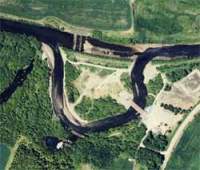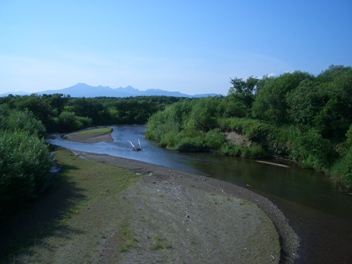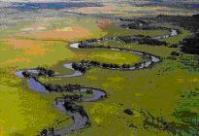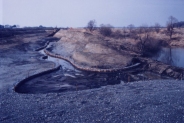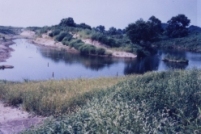
< World's WATERFRONT:JAPAN Category: Nature oriented restoration >
Shibetsu River has experienced constructions to straighten its winding stream to lower its underground water level, aiming at preventing flood and at better drainage of the basin, which was originally a peat district. Changes of the times have changed Shibetsu River’s requirements. With the local people’s voice asking for a better environment, Hokkaido Regional Development Bureau is working on a nature-restoring river development plan, aiming at restoring the nature-abundant original river conditions. In order to research the effect of straightened streams, the winding streams are partially restored as an experiment.
>>More details (PDF 51KB)
By JRRN-secre | Category: Nature oriented restoration,Hokkaido | Comment(0) | Trackback(0) |
Date: 2011.03.31 18:13
Kushiro River
(source: RFC)
|
The natural wetland environment of Kushiro River, which is a registered wetland designated under the Ramsar Convention in 1980, has deteriorated because of the land development in the surrounding area, the increased amount of sediment flowing into the wetland caused by the straightening of the inflow rivers and the lowering of the water table.
The "Kushiro Wetland Natural Environment Regeneration Project," is being conducted mainly by the Ministry of Land, Infrastructure, Transport and Tourism and Ministry of the Environment to rehabilitate and conserve the wetland by restoring the meandering streams to their original state and controlling the wetland vegetation.
>>More details (PDF39KB)
By JRRN-secre | Category: Nature oriented restoration,Hokkaido | Comment(0) | Trackback(0) |
Date: 2011.03.31 18:11
In the mouth of Fushino River running through Yamaguchi City, a vast tidal flat spreads, which is one of the greatest tidal flats in the West Setouchi region. It attracts migrant birds and it was selected as one of the 500 important wetlands in Japan.
However, due to the floating mud flowing in from the middle and upstream basins and the delay in taking domestic sewage countermeasures, oystershells were built up, the muddy tidal flat area was expanded and the biomass of fish, crabs and wild birds was decreased. To address this problem of the tidal flat ecosystem alteration a “framework to create a rich basin of Yamaguchi (Fushino River model)” was drawn up through collaboration between industry, educational institutions and the administration in March 2003. Today, the organizations concerned are cooperating to regenerate the tidal flats and create Zostera beds on a trial basis and wild bird research and beach cleaning is being performed.
By JRRN-secre | Category: Nature oriented restoration,Bay and lake restoration,Chugoku | Comment(0) | Trackback(0) |
Date: 2010.09.10 18:12
In Maruyama River Basin, the natural habitat was changed by agricultural land improvement, forest development and housing land development. In particular, ciconia boyciana have vanished in this area since 1971.
Today, ciconia boyciana (whose wild species are now extinct in Japan) is bred artificially in the prefectural “Ciconia boyciana Home Park” located in Toyooka City for release into the wild. As part of the environmental improvement measures to allow ciconia boyciana and various living organisms as a food source for ciconia boyciana, a river and waterfront environmental regeneration project is also being conducted.
By JRRN-secre | Category: Nature oriented restoration,Kinki | Comment(0) | Trackback(0) |
Date: 2010.09.10 18:10
In the middle basin of Shinano River, problems such as the simplified river channel, vanishing shallows and pools, change of high water channels into the land area and overgrowth of alien species such as robinia pseudoacacia have occurred because river improvement work focusing on flood control was promoted.
Now, however, a natural regeneration project is being conducted to restore the waterfront line (ecotone) and pools and recover the former channels. Also since July 2001, efforts have been made to increase the outflow from Nishiotaki Dam on a trial basis in cooperation with power generation companies. This is because the shallows are discontinued and algae proliferated abnormally due to a decrease in the river flow, which is caused by water intake for power generation and smoothing. While reviewing the effect and impact of an increase of the outflow on the downstream river environmental regeneration, we are improving the water environment adaptively and gradually.
By JRRN-secre | Category: Nature oriented restoration,Hokuriku | Comment(0) | Trackback(0) |
Date: 2010.09.10 18:04
In the peripheral area of No River flowing through Tokyo, a diversified environment consisting of springs, forests, wetlands and vegetation zones spread in the past. Today, however, the diversified natural environment has been damaged by the urbanization along the river and change of land use.
Nevertheless, a project is being conducted to regenerate the wetlands by using springs, create habitats or growing spaces for various organisms and provide a place for environmental education where people can commune with nature around No River Balancing Reservoir, which was constructed to prevent flooding.
By JRRN-secre | Category: Nature oriented restoration,Community and urban river restoration,Kanto | Comment(0) | Trackback(0) |
Date: 2010.09.10 18:03
The river bed of Kinu River has been lowered largely due to a decrease of sediment supply and gravel quarrying. As a result, problems such as immobilized gut for ships, single-row-shaped shoals, a decrease of the flood frequency in the riverside, invasion and overgrowth of alien species such as eragrostis curvula occur and the original pebble riverside is being lost.
As it is important to conserve and regenerate the plants that grow on the pebble riverside such as aster kantoensis (one of the endangered species) in particular, a natural regeneration project is being conducted to restore the pebble riverside and the natural environment with aster kantoensis and create an environment where native riverside organisms can live and grow sustainably.
By JRRN-secre | Category: Nature oriented restoration,Community and urban river restoration,Kanto | Comment(0) | Trackback(0) |
Date: 2010.09.10 17:58
In Sarobetsu Plain registered under the Ramsar Convention in 2005, the land becomes dry progressively due to the agricultural land improvement for developing dairy and arid plants such as sasa veitchii are increasing in number. The lowering water level of the marsh caused by a drainage project for bogs along with the agricultural land development is another problem.
Under the circumstances, the Sarobetsu natural regeneration project toward “coexistence of marsh and agriculture” is being conducted to recover the drying marsh and conserve the marsh by providing buffer zones in the agricultural land.
By JRRN-secre | Category: Nature oriented restoration,Hokkaido | Comment(0) | Trackback(0) |
Date: 2010.09.10 17:55
Utonai Lake located near the confluence of Bibi River and Yufutsu River was registered under the Ramsar Convention in 1991. On the periphery of the lake, a rich natural environment including wildernesses and wetlands has formed. It is also a treasury of animals and plants and a wild paradise to which migrant birds such as swans arrive in flocks.
However, the valuable natural environment and the ecosystem is vanishing due to the land development around the basin, causing a reduction of the volume of the spring in Bibi River, dryness of the marginal environment, outflow of soil, water quality deterioration, a decrease of the wetland area, vegetation change, etc.
Today, a natural regeneration project is being conducted to restore the state of Bibi River and Utonai Lake seen in the 1960s and 70s based on four pillars: recovery of the volume of the spring in Bibi River, improvement of the spring quality, recovery of the current speed and river channel and recovery of the wetland environment around Utonai Lake.
By JRRN-secre | Category: Nature oriented restoration,Bay and lake restoration,Hokkaido | Comment(0) | Trackback(0) |
Date: 2010.09.10 17:53
|
Before restoration
|
|
After restoration
|
Urbanization of Ara River basin gradually damaged its natural environment. Most areas of the plain with relatively conserved nature were riverbeds. Ara River biotope, 57 km away from the river mouth, is the midstream of the Ara River main stream. Hawks and foxes disappeared as the environment became worse. Given the situation, the wheat fields and meadows in the flat riverbeds have been improved to secure a large-scaled nature, good as the natural habitat, in combination with the neighboring Kitamoto nature watching park. Along the downstream, as a part of waterfront space development, banks are being developed in cooperation with the re-development projects.
>>More details (PDF 113KB)
By JRRN-secre | Category: Nature oriented restoration,Kanto | Comment(0) | Trackback(0) |
Date: 2008.03.31 18:04
<< Previous |
